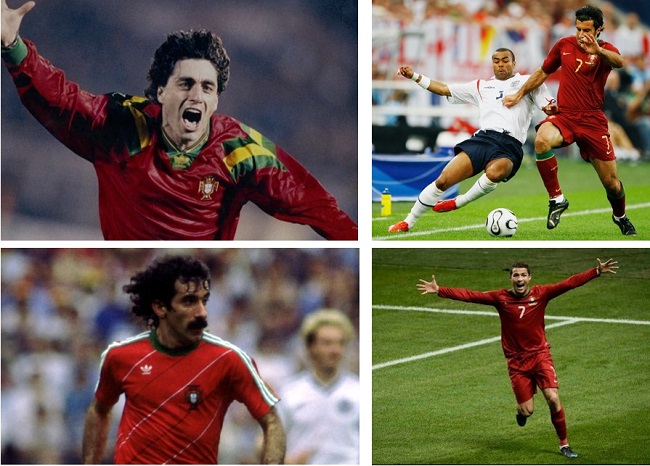
Think Portuguese football, and the first thing that comes to mind is wingers. Fast, talented, provocative, dazzling. If there’s any tactical position one can readily associate with the national game in Portugal, it has always been the wingman.
Whether it is because this is the position where individual talent has shone most brilliantly, or because supporters value the sense of spectacle they offer, or just because Portugal’s scintillating wide players have been gifted with uncommon doses of flair, it is here that we find most of the nation’s most memorable footballers.
It is hard to pick only ten of the country’s greatest wingers, and this A-list includes many of the world’s greatest ever players who are also the guardians of the DNA of Portuguese football history. PortuGOAL brings you Portugal’s all-time ten greatest wingers.
***
Luís Figo (127 caps)
In the summer of 2000, Luís Figo was the most loved and hated figure in the history of world football. That’s how big he was after deciding to move to Real Madrid following a five-season spell where he was the most beloved footballer in Barcelona. For a career that also included stints at Sporting and Inter Milan, it sums up pretty much his importance in the history of the game, but, most importantly, of Portuguese football.
The Almada-born winger won the Ballon d’Or that summer, partly because of all the fuss about his transfer, for his brilliant start for the Merengues and masterclass end of season at Barcelona. But, most of all, for being one of the best players during the Euro 2000, where he guided Portugal to the semi-finals. He was the first Portuguese player to win the accolade after Eusébio, and it was massive at the time. A Nike advertising global star, a sex symbol and one of the deadliest wingers ever to have lived, Figo was one of the most complete sportsmen of his day.

His career began at the Pastilhas local club in Almada, and he soon turned out to be the most glittering prospects in Sporting’s academy. Scratch that. In Portuguese youth football in general. He was a key player in Carlos Queiroz’s two-time under-20 World Champions, and had he been playing today, he would already be a global icon at 21. Those were different times, though, and he spent the following three seasons mastering his game at Sporting, under Bobby Robson and then Queiroz, before, in the summer of 1994, signing for Parma and Juventus at the same time, which had him banned from playing in Serie A, the world’s most coveted league at the time.
Johan Cruyff knocked at his door and he swiftly moved to Barcelona, where he became the best player in a side that would include the likes of Rivaldo, Guardiola and Luis Enrique over the following years. Twice league champion for the Blaugrana, he was by then already Portugal’s leading man, having played in the 1996 European Championship. That summer in 2000 changed his life forever. He became the first Galáctico and went on to win two more Spanish Leagues and the long-awaited Champions League trophy for Los Blancos. A lingering injury crippled his performance in the ill-fated 2002 World Cup, but two years later, there he was again, guiding Portugal into another memorable European Championship run, this time of home soil, even if it ended in tears after losing to Greece in the final. Two years later, it was Zidane’s France once again that prevented him from playing in a final, this time of the World Cup.
Fast, tricky on the ball and blessed with a deadly change of pace, moving from the outside to the inside where he could use his powerful shot, Figo was one of the most complete wingers in the history of football and a cultural and sporting icon for more than a decade.
António Simões (46 caps)
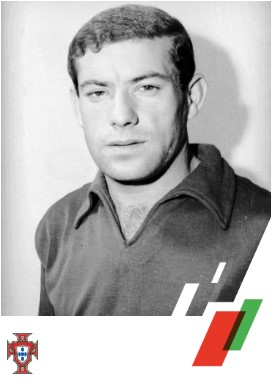 If everyone remembers the 1960s Benfica and Portugal sides because of Eusébio, they are quite within their rights. No player in Europe matched the Mozambican. Yet, both sides had many other talented players at their disposal, and few were as talented as António Simões, perhaps Portugal’s first great modern winger. Simões was already a star in his teens, the leading figure of Portugal’s under-20 team that won the first non-official youth Euros, a side coached by José Maria Pedroto at the beginning of his coaching career.
If everyone remembers the 1960s Benfica and Portugal sides because of Eusébio, they are quite within their rights. No player in Europe matched the Mozambican. Yet, both sides had many other talented players at their disposal, and few were as talented as António Simões, perhaps Portugal’s first great modern winger. Simões was already a star in his teens, the leading figure of Portugal’s under-20 team that won the first non-official youth Euros, a side coached by José Maria Pedroto at the beginning of his coaching career.
By then, despite only being 17, Simões had already played his first matches for Benfica, after a short spell in Almada. Aged only 18, he was already being picked by Bela Guttman to star in the European Cup final against Real Madrid, a night that would crown the Eagles as back-to-back European Champions. The likes of Águas, Coluna and Eusébio took all the credit, but Simões performed brilliantly on the wing against a seasoned defensive line. To this day, Simões holds the record as the youngest ever player to win a European Cup/Champions League final, aged just 18 years and four months.
For the following fourteen years, he would remain one of Benfica’s most important players, taking part in three other European Cup finals and amassing a total number of 312 matches and fifty goals to his name for the Eagles. With him in the ranks, the club lived a golden age summed up by the ten leagues he helped win. Short, extremely fast and with excellent technical skills, Simões was as strong on his left foot as he was on his right. During the 1966 World Cup, he was one of the main attacking threats of the Portuguese side that finished third, having played in all six matches and opening the score against Brazil, eliciting the roar of the Goodison Park crowd.
Simões was also outspoken and very aware of his role as a footballer and a Benfica icon. He joined the first players’ trade union, alongside Artur Jorge and Toni, two close friends, and after six years in the United States, he came back to be ever closely connected to his beloved Benfica.
 |
Ricardo Quaresma (80 caps)
Harry Potter in football boots. That was Ricardo Quaresma. A trickster, a magician, a player capable of the most unexpected, who made unpredictability his trademark. Quaresma is all that modern football is not. He couldn’t be tamed by tactics, never really fitted in a group and could not thrive in the obsessive passing game of the last decade. He was a maverick, a wonderer who patrolled the pitch waiting for a moment to shine. It could be with a small trick, a backheel pass, a juggling on the ball, something that came out of a cartoon or a sports ad. He made these moments real, though, and did it often enough to earn himself a legion of fans all over the world.
His most well-known trick, shooting with the outside of his right foot – the famed trivela – produced some of the best goals of the century and was there at the beginning and at the end of a two-decade career span. A brilliant product of Sporting’s famed academy, appearing at the same time as Cristiano Ronaldo but seen by many as far superior in technique and with a higher ceiling, he had an immediate impact in his first season for the Lions, helping them to win the 2001/02 league title. He then moved to Barcelona but was never able to follow in the footsteps of Figo and was eventually pushed aside by the genius of Ronaldinho Gaúcho.
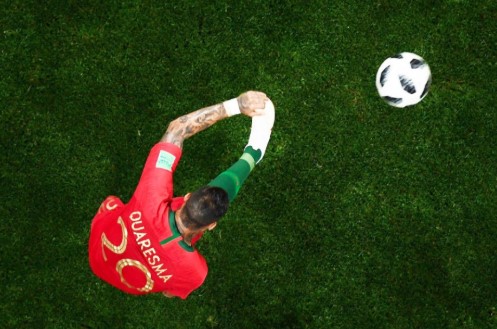
Back in Portugal, this time for FC Porto as part of the Deco transfer in the other direction, he once again made himself a fan-favourite by scoring against Benfica in the Portuguese Super Cup of 2004. That season didn’t end well, but an Intercontinental Cup preceded a league-title winning streak where his goals and assists were key to both Co Adriaanse and Jesualdo Ferreira.
With Luiz Felipe Scolari ignoring him in his call-ups for the national side, in 2008, Quaresma decided to take his chances in Italy under José Mourinho, who had just arrived at Inter. The two couldn’t be more different, and the player who had won Portuguese hearts never found his way into the Italians’. A short ineffective loan spell at Chelsea was followed by a move to Turkey, where he once again found solace. Quaresma became in Istanbul the same version of himself in the Portuguese league and drew crowds just to watch him play. A return to Porto ended poorly, and as he travelled back to safe ground at Besiktas.
He finally got his chance with Portugal at a major tournament and let nobody down. His goal against Croatia, the penalty versus Poland and his brilliant display in the final helped the nation lift its first international trophy at Euro 2016. Quaresma was now at peace with himself and even decided to return home, for a short, although interesting spell for Vitória SC, before finally retiring from the game as one of the most beloved wingers of the century.
Jesus Correia (13 caps)
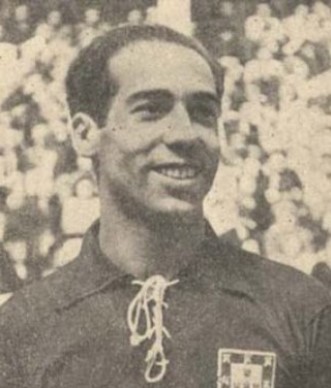 Sporting’s famous “Five Violins” forward line dominated Portuguese football during the 1940s, and they had in their number not only the goalscoring prowess of Fernando Peyroteo or the all-round quality of José Travassos, but they also boasted two of the nation’s first great wingers. In Jesus Correia, they had something else, an icon of two different sports. Correia was from Paço de Arcos and from an early age understood his life would be all about sports. He was good at several, but focused essentially on his roller hockey passion. He was one of the best in the world, his speed and technique allowing him to excel for his local side and also for the national side. Correia won six roller hockey World Cups for Portugal between 1946 and 1956, making himself a global icon for lovers of the sport.
Sporting’s famous “Five Violins” forward line dominated Portuguese football during the 1940s, and they had in their number not only the goalscoring prowess of Fernando Peyroteo or the all-round quality of José Travassos, but they also boasted two of the nation’s first great wingers. In Jesus Correia, they had something else, an icon of two different sports. Correia was from Paço de Arcos and from an early age understood his life would be all about sports. He was good at several, but focused essentially on his roller hockey passion. He was one of the best in the world, his speed and technique allowing him to excel for his local side and also for the national side. Correia won six roller hockey World Cups for Portugal between 1946 and 1956, making himself a global icon for lovers of the sport.
By then, he had also enshrined his name in football history. After an unsuccessful trial at Belenenses, who were close to home, he went on to play for Sporting’s youth graduates. Aged only 19, he made his debut for the first team of the Lions and played there for an entire decade, with 157 matches and 127 goals to his name, one of the best records in the club’s history. During that time Sporting conquered the famous Tetra (4 consecutive championship winners) among many other trophies, and he was inevitably called up to the national side, for whom he played on 13 occasions, making him the only elite sportsman who played for Portugal at the highest level in two different sports.
Many foreign clubs tried to sign him, especially from Spain, where he was already popular, but he never once thought of the prospect of leaving not only Sporting but his roller hockey passion. In 1953, he moved to CUF, where he played the remaining three years of his career before focusing exclusively on playing for a few seasons more in the hockey ring. A true gentleman, Correia was not only brilliant as a player but also a symbol of a bygone era.
Simão Sabrosa (85 caps)
It seemed Simão’s career was always chasing someone else’s shadow. Up to a point, few have given him the value he was worth because he fell short on comparisons. The talented winger from Trás-os-Montes came from the Sporting youth academy at the end of the 1990s, after some of his predecessors had floundered in the almost titanic task of forgetting all about Luis Figo’s celebrity status. Players like José Dominguez or Hugo Porfírio were never up to standards, and when Simão finally made a breakthrough into the first squad, he was next in line to be devoured by Sporting’s fatalism. Fast, skilful and deadly on set pieces, Sabrosa’s impact was immediate and even raised a virtual rivalry fuelled by the Portuguese sporting press against Hugo Leal, who was having to live with the same issues regarding Rui Costa at Benfica.

The Simãozinho nickname stuck for his first years dressed in green and white, and in the summer of 1999, he was transferred to Barcelona, who believed him to be the perfect successor to his idol, Figo. For a year, he worked as the understudy to the club star under Louis van Gaal, and after the summer of 2000, with Figo moving to Madrid, he was given the same number 7 shirt. Ironically, Simão scored in the first El Clássico at the Camp Nou against Real Madrid, but for the following months, he never produced the sort of displays the local crowd were expecting. In 2001, he was signed by Benfica to serve as a substitute for another legend, João Vieira Pinto, who had been let go on a free the year before. Although they played in different positions, Sabrosa was considered to be the natural leader of the squad due to his international profile, and comparisons with the golden boy of the old Estádio da Luz became inevitable.
It took him time to make a name for himself, but in 2004 he scored a winner against Mourinho’s Porto to deny them back-to-back Trebles. In the following seasons, under Giovanni Trapattoni, he emulated Pinto by guiding Benfica to a league title nobody expected them to win. By then, he was a regular for the Seleção, but while everyone expected him to establish himself in the first eleven, Cristiano Ronaldo entered the picture. Deemed too young to travel to the Euro 2000 and gravely injured before the 2002 World Cup, the 2004 Euro on home soil was to be his tournament, but the young Manchester United star stole the show, and Sabrosa was forced to be an understudy for a major chunk of his international career.
By 2008, he had earned himself a place in the starting eleven, with Figo out of the picture, and he was becoming famous at the Vicente Calderon after signing for Atlético de Madrid, where everyone decided to compare him with…Paulo Futre. He helped the Colchoneros win the 2010 UEFA Cup, playing in the final alongside Diego Fórlan and Sergio Aguero, and then moved to Besiktas and Espanyol before ending his playing career. Always in the shadow of someone deemed greater, Sabrosa did himself have a brilliant career in the end.
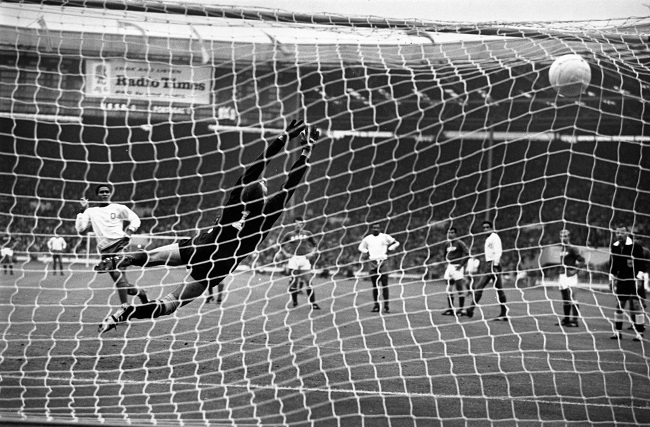 |
Fernando Chalana (27 caps)
When football historians are asked to rank the most technically gifted Portuguese players ever, his name is always up there. And that despite the fact he played at a time when few matches were shown on television, which speaks volumes. If it wasn’t for injuries or the ill-fated decision to move to France, helping Benfica to pay for the final works on the famous third ring of the Estádio da Luz, perhaps he would have achieved greater things. Fernando Chalana was a football genius. No defender ever knew what they would be up against when they faced him. As good with his left foot as with his right, he switched from one wing to the other, always with devastating effect. In truth, he was one of the first inverted wingers of the game, providing key assists from the right despite being usually deployed on the left.
Brilliant at set pieces, as fast as a thunderbolt, he was also aware of the role of entertainer he had for the crowds. Ever since his teens. A breakthrough prodigy at Barreirense, he signed for Benfica aged only 15 and made his debut for the first team two years later. That season he became the youngest player ever to be capped for Portugal and was also the youngest to score for his side in a home match. For a club in mourning after Eusébio’s career had drawn to a close, he came to fill the Eagles’ hearts once again with hope of a better future.
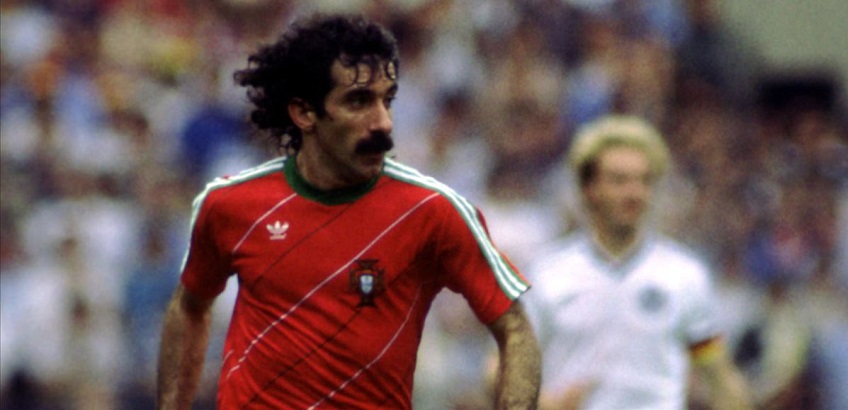
A key component of some of the club’s most memorable squads, especially the one coached by Sven-Göran Eriksson between 1982 and 1984, he was on the brink of taking Benfica back to continental glory, but his talents alone weren’t enough to beat Anderlecht in the 1983 UEFA Cup final. The following season, he made himself known to the world with a fantastic display during the 1984 European Championship in France. Nobody can ever forget how he destroyed the hosts’ defensive line during the epic semi-final played in Marseille, a match where he mesmerised a young fan named Zinedine Zidane, who had gone to celebrate his birthday and watch his idol Michel Platini. Two assists for Rui Jordão almost broke French hearts, but Portugal were eventually beaten in the dying seconds.
He had left such an imprint that Claude Bez, the owner of Bordeaux, decided to snatch him from Benfica to lead the assault on the French league and European glory. He was reluctant to leave, but it was a record transfer fee and helped his beloved club’s finances so much that he finally said yes, only to regret it almost instantly. The quality of the French league was below what he expected, the club’s facilities were poor despite the ambition of its chairman, and he began suffering continuous injuries that never allowed him to fulfil his potential despite winning several league trophies and playing in the European Cup.
He missed the 1986 World Cup because of one of those injuries, and Portugal suffered for it. In 1987, having played less than thirty competitive matches in three seasons, he returned to Benfica as the prodigal son. He wasn’t the same player, but the crowds loved him nonetheless and was he was on the bench for the 1988 European Cup final that Benfica lost on penalties against PSV. He then moved to Belenenses and Estrela da Amadora for brief spells before ending his career. His turbulent relationship with his wife Anabela, who also served as his agent, and financial issues due to some bad habits left him almost penniless but Benfica came to his rescue and offered him a job in the youth setups as coach, where he enjoyed nurturing talented players like Bernardo Silva, whom he once called mini-Messi, occasionally filling in as temporary coach for the first-team squad. A Benfica icon, through and through, Chalana was also a national star and one of the most beloved players ever to grace the game.
Nani (112 caps)
Once Portuguese wingers became popular worldwide, everyone was on the lookout for the next big thing. It became a burden to many who were growing up dreaming of being like their footballing idols and were called up at a tender age to make the same impact. Most of them failed in the process, never able to live up to expectations, but there was one who outranked all expectations.
Born in Amadora, son of an emigrant family from Cape Verde, Nani had a football star in him ever since he first played barefoot on the local pitches. He was street smart, dashing, and always looking to impress. He also had a work ethic that would take him far in his playing career, very different to other prospects like Fábio Paim, who came from the same background. Abandoned first by his father and then by his mother, he was raised by an aunt and knew football was his only way out. He first impressed at Real Massamá during his early teens and in 2003 signed for Sporting B, aged 17.
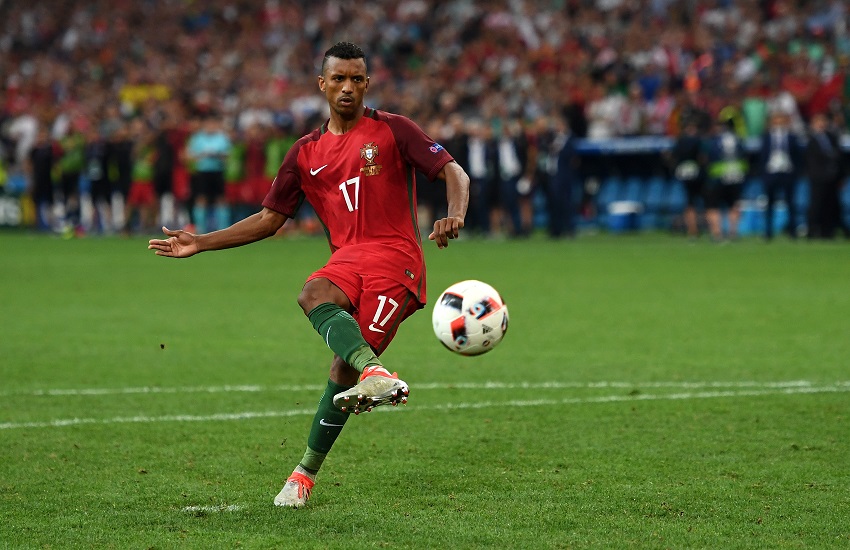
He was not an academy product as such, but spent two years living in the shadow of legends such as Futre, Figo, Simão and the recently promoted Quaresma and Ronaldo. He knew what was expected of him. In 2005, when Paulo Bento was appointed club manager, he was part of a generation of young academy graduates quickly promoted to the first side, and his impact was out of this world. The best player in the league in his debut season, he raised his game in the following season and was duly signed by Alex Ferguson to join Cristiano Ronaldo at Old Trafford. For three years, he served as understudy of the Portuguese star, playing as a substitute for a front-line that included Carlos Tevez and Wayne Rooney. He scored one of the penalties during the decisive shootout against Chelsea in the 2008 Champions League final, and when Ronaldo moved to Real Madrid in 2009, he inherited his place in the starting eleven.
Staying true to his own identity, he never relinquished the number 17 despite being offered the famed 7 shirt. By then, Nani had missed the 2010 World Cup due to injury but was key for Portugal in the following tournaments, leading the charge in 2016 when Ronaldo went off injured in the early stages of the final against France. By then, he had become an Old Trafford fan favourite, decisive in the club’s last Premier League win, but a series of injuries during the 2013/14 season led him to be loaned back to Sporting to gain form. He was key in guiding Sporting to a Portuguese Cup win that season, their first piece of silverware in six years, and then moved to Turkey, where, like with Quaresma, he became a fan favourite.
His trademark celebration, his easy shot and pace had the crowds on their feet, but after he shone for Fenerbahçe, his career meandered somewhat as he took the opportunity to travel the world. Lazio, a second loan to Sporting, a spell at the MLS for Orlando, Venezia, a trip to Australia and a comeback to Turkey have since been his most notable destinations and although Nani is milking his final years as a professional footballer, few doubt that the everlasting legacy he has left behind can never be tarnished. He remains, almost twenty years later, the last of the very great Portuguese wingers.
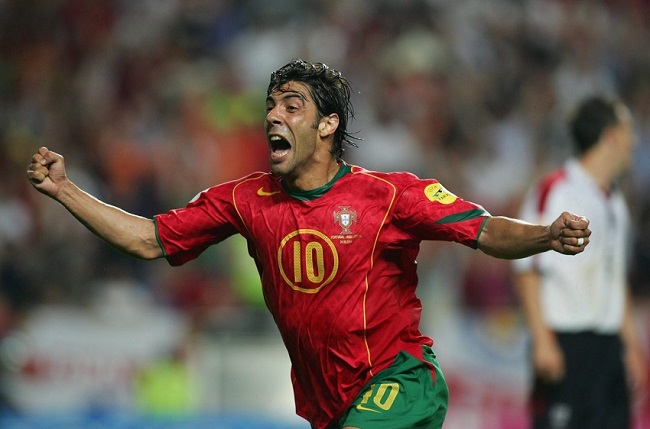 |
Paulo Futre: (41 caps)
Watching Paulo Futre play was like falling in love. Over and over again. Few footballers were as beloved and admired as him, and in Portugal, perhaps with the exception of Ronaldo and Eusebio, none were so respected by supporters from all sides. A Sporting academy graduate who became a world-class player with Porto’s shirt and enjoyed a memorable albeit short spell for Benfica that finished with one of the best ever displays by an individual player in a Portuguese Cup final, he was all that and much more. Nobody has a bad word to say about Futre, and that is one of the best things anyone can say about a footballer in Portugal.
He was the perfect definition of what the Portuguese winger is all about. A trickster, an arrow who knew how to drive (and dive) at the opposition at the right time, he was fast, creative, skilful and could score decisive goals. He was a leader on and off the pitch, but never stopped being an entertainer. A teenage icon at 18, by 21 he was already a European Cup winner, on a night where he almost scored what would have probably been the best goal in the history of all finals of the tournament.
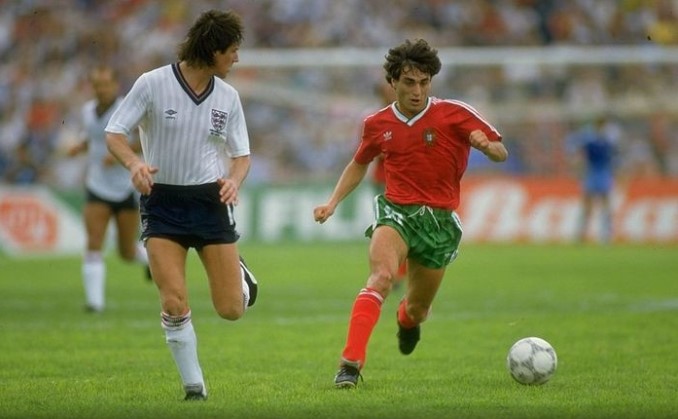
After three years winning everything for Porto, he had a chance to move to the Serie A or to La Liga. Had he chosen the first, we would probably be talking of a player who ranked almost at the level of Diego Maradona or Marco van Basten, who dominated the league and world football at the time. He went to Spain instead and signed for Atlético de Madrid. It cost him dearly, despite all the passionate affection of the local Colchonero crowd who rank him as the best player to wear the rojiblanco shirt, as he was never able to win the league due to the quality of Real Madrid’s Quinta del Buitre and Johan Cruyff’s Dream Team who, between them, won nine consecutive league titles with Atlético often finishing as runners-up.
In 1993, when he finally decided to move, he was first loaned to Benfica, where he was brilliant for a few months, and then he was transferred to Marseille. It seemed a logical step in his career as the French had just won the Champions League, but weeks later, the Valenciennes affair exploded, and the club was in disarray. Injuries and poor career decisions marked the end of Futre’s career, with short spells in Italy with Reggina and AC Milan – for whom he played a single match, enough to earn him the Serie A title – and West Ham, before a short spell back at Atlético.
By then, his body was already torn by injuries that prevented him from playing at Euro 96 alongside the promising Golden Generation who looked up to him as an idol. He was the first Portuguese international superstar and paved the way for the popularity of Portuguese players that the likes of Luís Figo and Rui Costa would benefit from. After his career ended, he became even more popular, working as sporting director for Atlético, presidential candidate at Sporting and a much-beloved TV pundit. Those who saw him play rank him higher than Figo, only below Cristiano Ronaldo and Eusébio in the history of Portuguese football. They might be right.
José Augusto (45 caps)
If Simões provided speed and perfectly timed crosses from the right in that 1960s Benfica side, José Augusto was the perfect counterpart on the left. He was a more skilled winger, with a great appetite for goalscoring, often shifting from the wing into the space that Eusébio created to make a difference. Born in Barreiro, he played for the local club until his 22nd birthday, when he was signed by Benfica. He was already a first-team player for the 1961 European Cup win and became firmly established in the first eleven the following season, which coincided with the arrival of Simões, Eusébio and also a young José Torres, who would then replace José Águas as poacher.

Augusto played for a decade for the Eagles, winning not only two European Cups and eight league titles but also becoming a stalwart for the national side, playing and scoring on three occasions during the 1966 World Cup finals. He was usually the rescue man on those days when Eusébio was not at his best, and he left an impressive legacy before ending his career at only 32. He began a coaching career that included the Portugal job, first in 1971 and then as one of the deputies at Euro 84. He also enjoyed short spells as Benfica’s caretaker manager and led several minnows in Portuguese football for the best part of three decades, and even coached Portugal’s national women’s team.
Not as fast as Simões, he used his football brain to make a difference, a sort of forward who drifted from the flank more than an old-school winger, which eventually made him a pioneering figure that would become more popular as time went by.
Cristiano Ronaldo (223 caps and counting)
It’s extremely hard to define Cristiano Ronaldo as a winger. He was one of the best in the world at it, but for more than a decade now, he has converted himself into an all-around attacker. One of the best players of all time, one of the few who can enter the discussion of who belongs to the top five in the history of the game, there are several Ronaldos during a career that his now entering its 23rd professional season ever since his brilliant debut for Sporting.
Born in Madeira in 1985, he moved before his was a teenager to the Sporting academy as one of the most promising attackers of his generation. He was used both as a forward and a winger in the youth setups, and his taste for flashy nutmegs, tricks and juggles, more likely to be seen in popular TV ads than on professional pitches, made him extremely popular among the youth academy followers. When he was finally called up by László Bölöni to Sporting’s first-team squad, he proved to be much more than that. He was already a goalscorer at heart, although it took him a few years to develop those predatory skills that would lead him to worldwide celebrity. After scoring against Moreirense in his first home league match, he was a regular substitute in 2002/03.
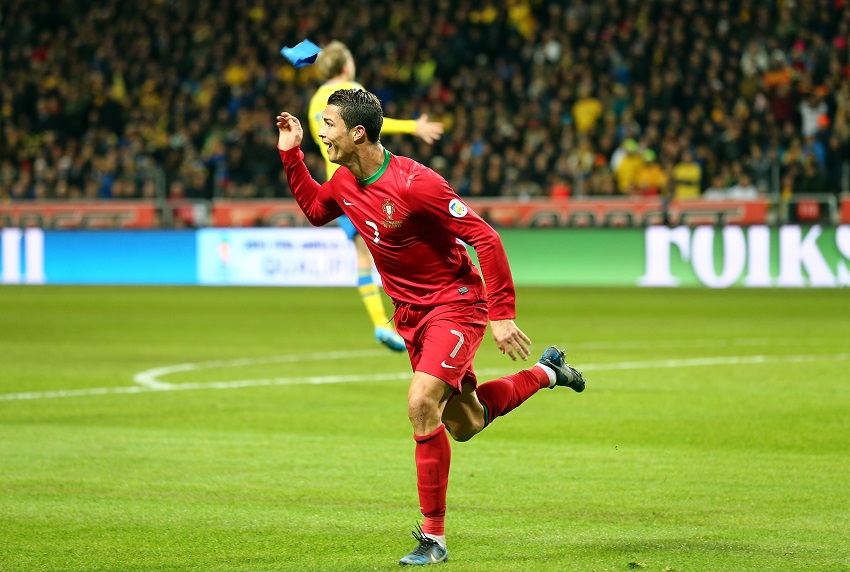
Scouted by the best sides in Europe, he announced himself to the world the following August, during the club’s official inauguration match of the new Alvalade stadium. Against Manchester United, he ran riot against the visitors’ defence and the club, who had already agreed to sign him at the end of the season, decided he was ready for the challenge. He travelled a few days later to Manchester and, after a slow start, became a regular starter.
For the following five years, he would run the Premier League with his flashy and passionate style of play that would evolve progressively into a more mature version, with nutmegs replaced by deadly free-kicks and decisive headers. Ronaldo led United to three Premier League titles and a Champions League trophy before moving to Madrid. By then, he was already renowned around the world, a Ballon d’Or winner and regarded as one of the best players in the game. He was also leading Portugal since coming of age at Euro 2004 and the 2006 World Cup, particularly after the Golden Generation, Luís Figo and Rui Costa foremost among them, retired from international duty, and he became the leader of the new generation of players.
It would take him twelve years from his first tournament to win his first trophy for Portugal in France at Euro 2016, followed by two Nations League triumphs in 2019 and 2025. By the latter, he was already nearing the end of his brilliant career after an iconic nine-year spell at Real Madrid, where he won 4 Champions League titles, three Spanish leagues and broke all the records, including four more Ballon d’Or awards as the best player in the world. Converted into a poacher, he became the top Champions League and international goalscorer of all time, adding trophies in Italy with Juventus as well before a short return to Old Trafford and a subsequent move to Saudi Arabia. Probably the world’s most popular and iconic player of all time, Ronaldo is obviously the perfect representation of why wingers have been so enshrined in Portuguese football DNA for so long.
By Miguel Lourenço Pereria, author of “Bring Me That Horizon – A Journey to the Soul of Portuguese Football”.

